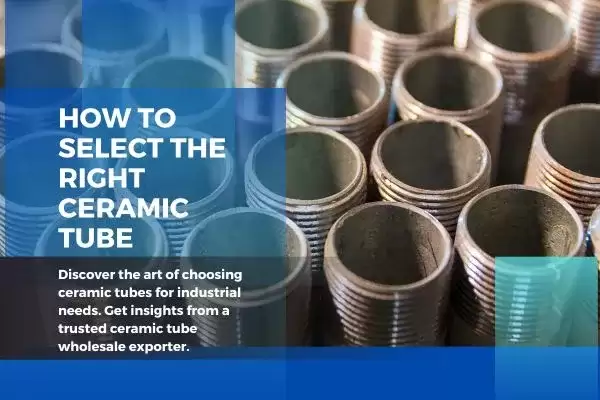
Sep 1,2023
Regarding industrial applications, the importance of selecting the right ceramic tubes cannot be overstated. These versatile components are critical in various processes, from manufacturing to research. However, with numerous available options, choosing the ideal ceramic tube can be a daunting task. In this guide, we will walk you through the essential factors to consider when selecting, all while keeping an eye on finding a reliable ceramic tube wholesale exporter.
Before diving into the selection process, let's get to know ceramic tubes better. These cylindrical wonders are typically made from advanced ceramic materials such as alumina, zirconia, or silicon carbide. Their unique properties, including high-temperature resistance, excellent thermal conductivity, and superb electrical insulation, make them indispensable in various industries.
The first step in selecting the right ceramic tube is choosing the appropriate material. Each ceramic material type has distinct properties that make it suitable for specific applications. For instance, alumina ceramic tubes are an excellent choice if you require high thermal conductivity. On the other hand, if you need exceptional resistance to chemical corrosion, silicon carbide may be the way to go.
To make an informed decision, consider your application's demands and consult with a knowledgeable ceramic tube wholesale exporter who can guide material selection based on your specific needs.
Size matters. Accurate measurements and tight tolerances are crucial when selecting ceramic tubes for your application. Variations in dimensions or tolerances can lead to inefficiencies or even equipment failures. Therefore, working with a ceramic tube supplier that can provide products with precise dimensions and the required tolerances is essential to ensure optimal performance.
Ceramic tubes are often subjected to extreme temperatures and rapid thermal changes. If your application involves high-temperature processes or frequent thermal cycling, choosing ceramic tubes with the appropriate temperature and thermal shock resistance is vital. For example, Alumina and silicon carbide ceramic tubes excel in high-temperature environments and can withstand thermal shock better than most materials.
For applications involving electrical insulation, selecting ceramic tubes with the right electrical properties is crucial. These properties include dielectric strength, electrical conductivity, and insulation resistance. Depending on your specific requirements, you may need a ceramic material that is an excellent electrical insulator or one that conducts electricity efficiently. Carefully evaluate these properties to ensure they align with your application's needs.
The surface finish of ceramic tubes can significantly impact their performance, especially in applications where tight seals or low friction are essential. The surface finish affects factors such as wear resistance and the ability to maintain a gas-tight seal. Consider the surface finish specifications offered by your chosen ceramic tube wholesale exporter to ensure they meet your requirements.
While quality is paramount, cost-effectiveness is also a key consideration. Balancing performance with budget constraints is often a challenge. However, working with a reputable ceramic tube supplier can help you find cost-effective solutions without compromising quality. Compare quotes from multiple suppliers to ensure you get the best value for your investment.
Sometimes, off-the-shelf ceramic tubes may not meet your exact requirements. In such cases, partnering with a ceramic tube wholesale exporter that offers customization options can be a game-changer. Customized ceramic tubes can be tailored to your specific dimensions, tolerances, and material properties, ensuring a perfect fit for your application.
When sourcing ceramic tubes, reliability is non-negotiable. A reliable supplier should adhere to strict quality control standards and provide certifications to guarantee the quality and consistency of their products. Look for a ceramic tube wholesale exporter with a track record of delivering high-quality, reliable ceramic tubes to their customers.
Now that we've discussed the crucial factors to consider when selecting ceramic tubes, let's circle back to our keyword, "ceramic tube wholesale exporter." Finding the right supplier can make or break your ceramic tube procurement experience.
To ensure you're partnering with the best ceramic tube wholesale exporter, consider the following:
Reputation: Look for suppliers with a solid reputation in the industry. Customer reviews and testimonials can provide valuable insights into their performance and reliability.
Experience: An experienced supplier is more likely to understand your unique needs and provide tailored solutions.
Certifications: Verify that the supplier complies with industry standards and holds relevant certifications for their products.
Customer Support: Excellent customer support is essential. Choose a responsive and readily available supplier to address your inquiries and concerns.
Global Reach: If your business operates internationally, working with a global supplier can simplify logistics and ensure timely deliveries.
In conclusion, selecting the right ceramic tubes is a crucial decision that can significantly impact the success of your industrial processes. You can make an informed choice by considering factors such as material, dimensions, temperature resistance, electrical properties, surface finish, cost-effectiveness, customization options, and supplier reliability. Don't forget to partner with a reputable ceramic tube wholesale exporter who can provide top-quality products tailored to your needs. You'll be well-equipped to tackle even the most demanding applications with the right ceramic tubes.